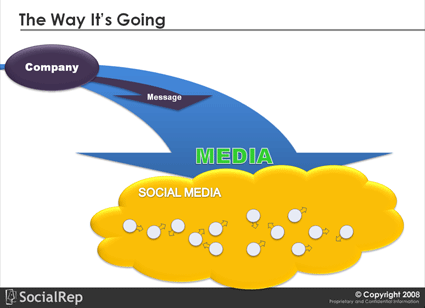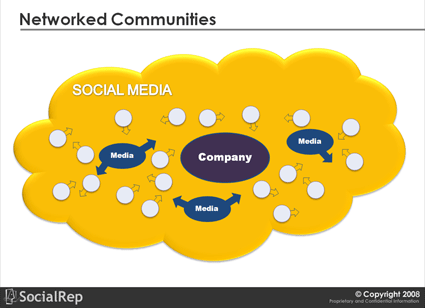 If you ask marketing executives what keeps them up at night in the age of social media, one of the most common responses is fear of a PR debacle lighting a brush fire on the web. Every marketer knows there are a hundred things that could go wrong on any given day–from product failures to employee indiscretions–and the fear of being caught flat-footed while the news lights up the social universe is a very real fear. In fact, one of the biggest market drivers for my company SocialRep is the need for businesses to have an ear to the ground and a way to effectively manage engagement.
If you ask marketing executives what keeps them up at night in the age of social media, one of the most common responses is fear of a PR debacle lighting a brush fire on the web. Every marketer knows there are a hundred things that could go wrong on any given day–from product failures to employee indiscretions–and the fear of being caught flat-footed while the news lights up the social universe is a very real fear. In fact, one of the biggest market drivers for my company SocialRep is the need for businesses to have an ear to the ground and a way to effectively manage engagement.
Surprisingly few companies, however, have protocols in place to manage social media disasters as they unfold–even those that have sophisticated crisis management protocols in place for non-social media issues.The good news is, it’s not that hard to create a plan. In fact, the most important things you need to know were modeled for you in kindergarten. Remember those fire drills? The simple but critical idea was that everyone should know exactly what to do and where to go when a crisis happens, and to practice it even when the possibility of an actual crisis seems remote. Same idea applies to social media.
Why is this important? Think of social media as a massive global amplifier. Events that you used to be able to ignore until they went away can now become an overblown incident with a permanent record on Google. A trivial customer complaint magnified through social media can become an international embarrassment overnight. If you need graphic examples of disaster, Jeremiah Owyang offers a chronicle on his blog.
So here’s a primer on how to build your own crisis plan for social media, whether the crisis is an overblown customer complaint, or a true business disaster affecting many customers.
These recommendations should dovetail with an established crisis management program. If you don’t have established crisis protocols, there’s a section at the end of Part 2 that will lay out the basics.
Be Prepared
We put a lot of resources into maintaining resources like flood control systems and fire roads. Why? Because the cost of eventual disaster vastly outweighs the cost of being ready to respond. Social media is the same way. Facing down a crisis is not the time to wish you’d developed the resources to respond.
- Start getting engaged now. If you don’t already have people in your company building social relationships with your business communities, you won’t have the channels to deal with a crisis when it hits. When a crisis happens, you need to be able to communicate directly with your business communities through channels you’ve already established; you can’t borrow or buy them from your PR firm.
- Build your team. If you don’t already have a social media A-Team, you should. Social media should not be relegated to the PR team or the young people in your organization. It should be a distributed practice that helps your company develop relationships on every operational front. Your engineers should be engaged with the engineering community. Your customer service reps should be engaged with customers. Your legal team should be engaged and up to speed with the legal community. You get the idea. Fortunately, building an A-team isn’t hard, and I’ve written a primer for that too.
- Get your ears on. One of the big advantages of being socially connected is real-time intelligence. If you’re tracking social media–even using basic tools like Google alerts–you’re likely to get wind of a problem before it becomes a brush fire. The more sophisticated your tracking experience, the more you’ll be able to discern real threats from fire drills. This is something that should be distributed across your team, as explained in the A-team primer.
- If you don’t already have a news section for your website with a feed for the latest news on your homepage, you should think about establishing one. When a crisis hits, traffic to your site will spike with people looking for information. Provide updates people can find quickly. If the crisis is a fast-moving or emerging problem, use your CMS system or a blog to give updates with an RSS feed your market can subscribe to.
- If the crisis is substantial, create a dedicated response page, and do so quickly. This goes beyond providing information, and impacts search engine results. In time of a crisis, search engine requests for information about the crisis will grow, and you want to have a point of presence in the top organic results. If you have a blog, write posts that point to your news item and your dedicated page. If you have a Facebook group, and Twitter handles, do the same.
- Some SEO experts recommend buying search terms, and even domains, with generic crisis terms to ensure search engine positioning when something goes down. Like [your company] and “failure”. Or “breach”. Choose words that relate to the kinds of crises you would plan for in your line of business. Create landing pages with neutral and generic language to optimize search traffic. When a crisis hits and someone Googles it, you’ll already be ready with a page in the top results.
Know the Tools
While standard crisis communication tools like press releases, press conferences, and video press releases are still important, social media has its own resources that can help you get the word out in a crisis. In most cases, you’ll use social media channels to point people back to your response page on your own web site or blog, where information about the crisis is provided.
- Tracking. Staying on top of the daily stream of dialog is the best way to identify a crisis before it blows up. For basic tracking, set up Google alerts to track your corporate and product brands. You can use Twitter search to find discussions about your brand, and set up an RSS feed for monitoring. If you have more complex tracking needs, this is precisely what SocialRep does, but I don’t recommend jumping into technology adoption before you start with the basics laid out in the A-team primer. Your proven business processes should drive technology, not the other way around.
- Twitter has emerged as probably the fastest conduit of news in the world today. It’s ubiquitous and immediate. People were tweeting news of the Mumbai attacks in real time, and even news networks were following the threads. If you have a crisis, getting the word out with a link to your own response page is critical, and Twitter is one of the best ways to do it. Having an active Twitter presence is a good idea aside from crisis management, but having an existing network in the event of a crisis will ensure you’re able to get the word out far more quickly.
- FriendFeed is rapidly emerging as a channel for real-time threaded dialog, kind of like Twitter, but with more emphasis on dialog, as opposed to broadcast micro-posts. Like Twitter, there’s good reason to be engaged on FriendFeed aside from crisis preparedness, but having an active network will be invaluable when a crisis happens. In a crisis, post a one-sentence announcement with a link to your response page.
- Facebook is a great tool for managing the ongoing dialog with your community after the crisis initially unfolds. An existing corporate Facebook group may be fine for managing minor crises, but if there’s a major crisis that gains substantial attention, you’ll want to establish a dedicated group, with a reference to the crisis in the title. Others will create groups to talk about it, so you want a presence in Facebook’s Group search results, not buried in your corporate group among discussions about your Christmas party. You can post links to your response page, video, and discussions group threads. Ideally, you’ll want to point any traffic for dealing directly with the crisis back to your own Web site rather than have crisis response distributed over the Web. But you can use discussion threads on Facebook to talk about the broader issues that impact your brand, such as how you’ve dealt with the crisis and the aftermath.
- LinkedIn has far less utility for crisis management than the tools previously mentioned, but if you maintain links to professional or corporate groups relevant to your business, this could be a good channel of communication in a crisis. Especially to the extent that communications in this channel are managed primarily by email, so you may reach professionals who are not yet wired in to the other social networks.
- YouTube and Seesmic are potentially good channels for posting a video message from your CEO in response to a social media crisis. In most cases, this will be most effective for wrap-up information and framing of the whole event, rather than real-time management of the crisis. Though I’m sure someone will do a YouTube press conference one of these days.
In Part 2, we’ll look at crisis management techniques for social media, basic crisis management planning, and do’s and don’t’s of dealing with a social media crisis.
If you have your own ideas, tips or criticisms, feel free to comment.
Photo credit: kryst£n



